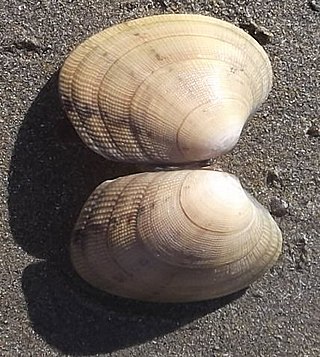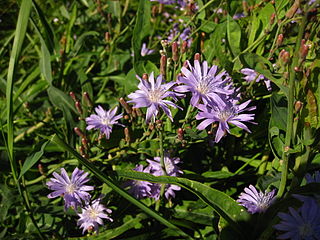Genus is a taxonomic rank used in the biological classification of living and fossil organisms as well as viruses. In the hierarchy of biological classification, genus comes above species and below family. In binomial nomenclature, the genus name forms the first part of the binomial species name for each species within the genus.

Conidae, with the current common name of "cone snails", is a taxonomic family of predatory sea snails, marine gastropod molluscs in the superfamily Conoidea.

Murex is a genus of medium to large sized predatory tropical sea snails. These are carnivorous marine gastropod molluscs in the family Muricidae, commonly called "murexes" or "rock snails".

Papilio is a genus in the swallowtail butterfly family, Papilionidae, as well as the only representative of the tribe Papilionini. The word papilio is Latin for butterfly.

Systema Naturae is one of the major works of the Swedish botanist, zoologist and physician Carl Linnaeus (1707–1778) and introduced the Linnaean taxonomy. Although the system, now known as binomial nomenclature, was partially developed by the Bauhin brothers, Gaspard and Johann, Linnaeus was first to use it consistently throughout his book. The first edition was published in 1735. The full title of the 10th edition (1758), which was the most important one, was Systema naturæ per regna tria naturæ, secundum classes, ordines, genera, species, cum characteribus, differentiis, synonymis, locis or translated: "System of nature through the three kingdoms of nature, according to classes, orders, genera and species, with characters, differences, synonyms, places".

Strombus is a genus of medium to large sea snails, marine gastropod molluscs in the family Strombidae, which comprises the true conchs and their immediate relatives. The genus Strombus was named by Swedish Naturalist Carl Linnaeus in 1758. Around 50 living species were recognized, which vary in size from fairly small to very large. Six species live in the greater Caribbean region, including the queen conch, Strombus gigas, and the West Indian fighting conch, Strombus pugilis. However, since 2006, many species have been assigned to discrete genera. These new genera are, however, not yet found in most textbooks and collector's guides.

Charonia is a genus of very large sea snail, commonly known as Triton's trumpet or Triton snail. They are marine gastropod mollusks in the monotypic family Charoniidae.

Ostrea is a genus of edible oysters, marine bivalve mollusks in the family Ostreidae, the oysters.

Arctia is a genus of tiger moths in the family Erebidae. Therein, it belongs to the subtribe Arctiina in the tribe Arctiini in the subfamily Arctiinae. Species are well distributed throughout North America, Palearctic, India, and Sri Lanka.

Utetheisa pulchella, the crimson-speckled flunkey, crimson-speckled footman, or crimson-speckled moth, is a moth of the family Erebidae. The species was first described by Carl Linnaeus in his 1758 10th edition of Systema Naturae.

Cypraea is a genus of medium-sized to large sea snails or cowries, marine gastropod mollusks in the family Cypraeidae, the cowries.

Venerupis decussata is a marine bivalve mollusc in the family Veneridae, commonly known as the cross-cut carpet shell.
Kuphus is a genus of shipworms, marine bivalve molluscs in the family Teredinidae. While there are four extinct species in the genus, the only extant species is Kuphus polythalamius. It is the longest bivalve mollusc in the world, where the only known permanent natural habitat is Kalamansig, Sultan Kudarat in the Philippines.

Lactuca tatarica, known as blue lettuce, is a Eurasian flowering plant in the tribe Cichorieae within the family Asteraceae. It is widespread across much of Europe and Asia.

Sertularia is a genus of hydroids in the family Sertulariidae.

Cyrtacanthacris is the type genus of grasshoppers in the subfamily Cyrtacanthacridinae. Species records are distributed in Africa through to Indo-China.

Anoscopus albifrons is a species of insect in the family Cicadellidae. It was first described by Carl Linnaeus in 1758, in the 10th Edition of his Systema Naturae. It is found throughout Europe, the Azores, and parts of the United States and Canada. It inhabits grassy areas and forbs.
















